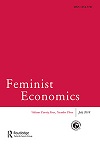Economic Development and Women's Labor Force Participation in India

India has experienced steady economic growth over the last two decades alongside a persistent decline in women's labor force participation (LFPR). This paper explores the relationship between economic development and women's labor supply using state-level data spanning the period 1983–4 to 2011–2. While several studies suggest a U-shaped relationship between development and women's labor force participation, our results suggest that at the state level, there is no systematic U-shaped relationship between level of domestic product and women's LFPR. On examining the relationship between the structure of the economy and women's economic activity, we find that it is not economic growth but rather the composition of growth that is relevant for women. Further, our results suggest that aggregate changes in the proportion of women in the workforce can be mostly attributed to the movement of the workforce across sectors rather than changes in the proportion of women workers within a sector.
Economic Development and Women's Labor Force Participation in India

India has experienced steady economic growth over the last two decades alongside a persistent decline in women's labor force participation (LFPR). This paper explores the relationship between economic development and women's labor supply using state-level data spanning the period 1983–4 to 2011–2. While several studies suggest a U-shaped relationship between development and women's labor force participation, our results suggest that at the state level, there is no systematic U-shaped relationship between level of domestic product and women's LFPR. On examining the relationship between the structure of the economy and women's economic activity, we find that it is not economic growth but rather the composition of growth that is relevant for women. Further, our results suggest that aggregate changes in the proportion of women in the workforce can be mostly attributed to the movement of the workforce across sectors rather than changes in the proportion of women workers within a sector.
